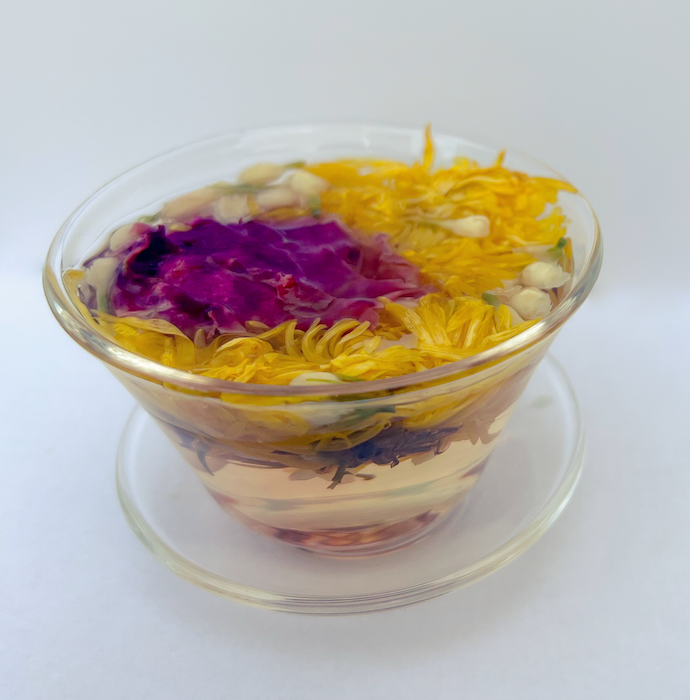
Spring Wellness: Three Flower Tea 三花茶
There is a Chinese folk proverb:
春饮花茶,夏饮绿茶,秋饮青茶,冬饮红茶。
Drink flower tea in spring, green tea in summer, qing cha 青茶 (light oolong) in autumn, and black tea in winter.
Spring is the season associated with waking up, growth, and the liver organ system. It is when all the flowers start blooming outdoors. So it is intuitive that a refreshing and fragrant flower tea would be appropriate at this time, especially considering that many types of flower tea have beneficial properties for our liver organ system. In particular, we will look at variations of Three Flower Tea (San Hua Cha 三花茶).
Flower teas are usually pretty gentle, however, as with everything it is best approached in moderation. When in doubt, it’s always a good idea to check in with a Chinese medicine professional to get an assessment about what is most beneficial to your particular constitution.
Three Flower Tea (San Hua Cha 三花茶)
Three Flower Tea is a famous flower tea combination, and actually there are many variations that can go by this name.
One of the most popular variations contains rose, chrysanthemum, and honeysuckle. We will look at this one, as well as two other variations below.
* Note that these are all dried flowers (ideally organic) that you would want to purchase from a reputable source that offers flowers which are to be used for consumption/tea.
Rose, Chrysanthemum, Honeysuckle
Rose (meigui hua 玫瑰花): Rose is warm in nature, sweet in taste, and enters the liver and spleen meridians. Rose can regulate and move qi, harmonize the blood, and is good for relieving liver qi stagnation. It is also very popular among women as it can relieve irregular menstruation and beautify the skin.
Chrysanthemum (ju hua 菊花): Chrysanthemum is in the category of herbs that release to the exterior. It has a sweet and bitter taste, is slightly cold (cool) in nature, and enters the liver and lung meridians. It can clear heat, disperse wind, calm the liver, stimulate blood circulation, purify the blood, and improve eyesight. White chrysanthemum is considered best for nourishing the liver and improving eyesight, whereas yellow chrysanthemum is considered better for wind-heat dispersing, draining fire, and detox.
Honeysuckle (jinyin hua 金银花): Honeysuckle is cold in nature and sweet in taste. It enters the large intestine, lung, and stomach meridians, and has the functions of clearing heat and detoxifying.
It is important to note that honeysuckle (jinyin hua) is a particularly cold herb and so may make this version of San Hua Cha unsuitable for some. Particularly, if your constitution is such that you have a weak spleen and stomach this version may not be the best choice. Pregnant or menstruating women might also want to steer clear. Below are a couple of great variations that I enjoy that replace honeysuckle with flowers that have a warm rather than cold nature.
Rose, Chrysanthemum, Jasmine Buds
In this variation we replace honeysuckle with jasmine (moli hua 茉莉花). Jasmine regulates qi, it is warm and its taste is sweet and acrid. It enters the spleen, stomach, and liver meridians. It can regulate qi flow, harmonize the spleen and stomach, and resolve depression.

I first heard about this variation of San Hua Cha from my friend Seth who is an experienced Chinese medicine practitioner and fellow neigong practitioner. He told me about its soothing nature and its ability to relieve depression and said that one of his clients who had been drinking it regularly felt it completely turned her life around.
Rose, Chrysanthemum, Osmanthus
In this variation of San Hua Cha we use osmanthus (Gui Hua 桂花) which is quite fragrant and tasty. Osmanthus is warm in nature and enters the kidney, lung, spleen, and liver meridians. It is nourishing and soothing and can tonify the kidneys, cleanse the liver, dissipate stasis, resolve phlegm, reduce inflammation, and nourish and moisten the lungs. It is also beneficial for the skin.
To make San Hua Cha I use a small glass kettle and add filtered (or spring) water that I bring to a boil. Flowers are delicate and do not need to be boiled at a high temperature or for too long. You can also simply just add boiling water, but I find it better to give them just a bit more of a boil (note that I also live at a descent altitude above sea level, so water boils at a lower temp for me). I usually add the chrysanthemum and third ingredient (jasmine, osmanthus, or honeysuckle) first and boil that at a low rolling boil for a couple of minutes. I then add the rose, remove from heat, cover and let sit for at least five minutes.
You can experiment with different amounts of each flower. For chrysanthemum I use one or two dried flowers if they are the large variety, and a small handful if they are the small ones. For honeysuckle I would only use a pinch. For jasmine buds, I add a small handful. For osmanthus, I go with just a large pinch. For roses, I use just one or two if they are the large flowers or maybe 3-5 if the smaller ones.

